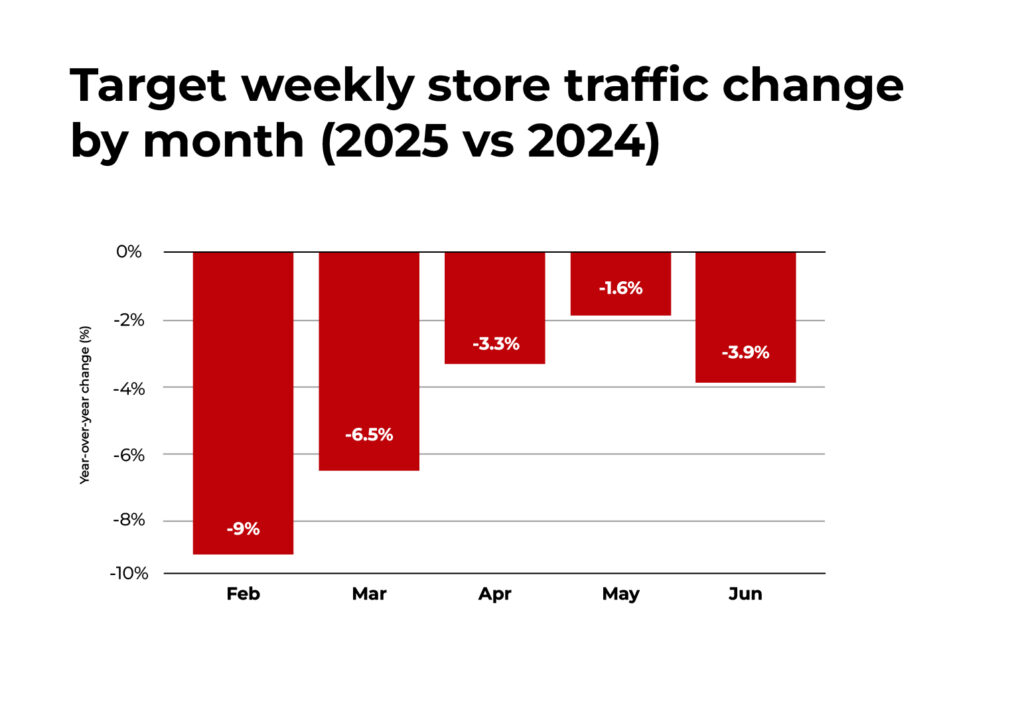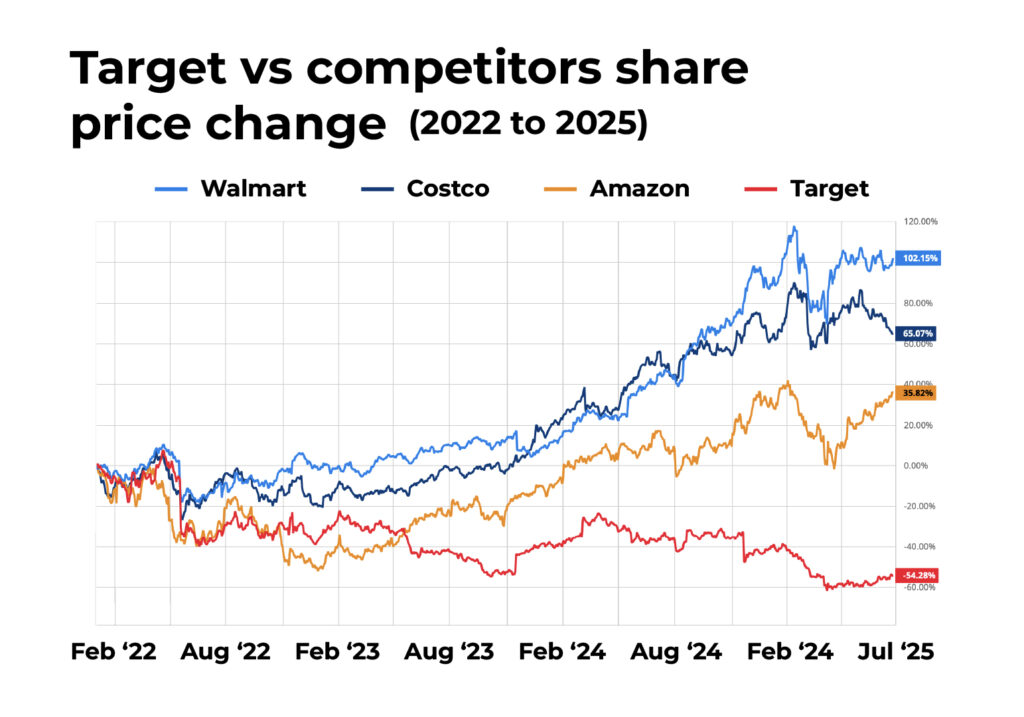If Target’s leadership had sat down and written a business plan for how to destroy brand and business value, they couldn’t have done it better. I’d like to briefly summarize Target at its apogee, what they did to go downhill and then draw lessons for all of us.
What Target did right—Target at its apogee
Target created a brilliant and category disrupting brand, which generated a large amount of value, driving revenue, profit and market share growth. Consumers flocked to it; investors bought its shares. It became one of the most admired companies in America.
How did Target achieve such success?
They repositioned the brand. Target’s brand purpose became “To help all families discover the joy of everyday life.” And its positioning: ‘Target is the place to find affordable, everyday essentials, fun, ease and inspiration at every turn, no matter when, where or how you shop. ‘The core idea was to be upscale but at value-oriented prices, something that had never been attempted by a big box retailer. A brand that was truly for everyone—rich and poor.
And they delivered on it.
Avant-guard design. Stores designed at the sort of premium level you’d expect from high-end retail. That cool Target logo of red circles, immortalized on those bags. Inviting stores. Very clean, well laid out, intuitive to navigate. You could find what you wanted. Shelves always stocked. Great inventory management.
Merchandise that was affordable, yet cool and fashionable. Clothes that anyone would be happy to wear. Chic home, kitchen and bathroom products. Interesting, not boring and dowdy. To draw attention to this, they pioneered special collections from famous designers, a practice since widely copied, by everyone from H&M on.
Wonderful customer service.
It worked. It became trendy to shop at Target. Upscale customers flocked in. it became cool to show off how fashionable you could be while spending at discount prices. They referred to it by the affectionate joking nickname “Tarzhay”, Target as you’d say it if it was French. The bulls-eye bags became ubiquitous.
Revenues grew…Profits grew. The share price soared.
What Target then did wrong—Target’s plan to destroy brand and business value
First, and above all, Target ceased to deliver on its brand promise.
It happened gradually, gradually, bit by bit.
First, operations and inventory management. COVID accelerated it. COVID caused all retailers supply chains to suffer. But Target managed its operations worse than the rest. Early in the pandemic, shoppers were few, merchandise piled up and Target was forced to unload it at steeply discounted prices, taking heavy losses. The company then reacted by cutting inventory, impacting the availability of goods on the shelves.
Then, the staff was cut. An 8% reduction, 35,000 people less. As a quick fix, Target focused on online retail. According to its inefficient model, staff were used to find the items to ship on store shelves. They had no time to spend on keeping the stores tidy and well-stocked.
There was a dearth of products. Shelves were empty. The things you were looking for were never there. Target was no longer delivering on the brand promise of fully stocked shelves.
Customer service declined. There weren’t enough staff, and they were under too much pressure to be attentive to shoppers. You couldn’t find help if you needed it, or even someone to check you out. Store maintenance was not kept up. Stores grew shabby and messy. Target ceased to be a ‘premium’ shopping experience.
Shoplifting increased. Target, like many retailers, reacted by placing many products in cabinets under lock and key. This reduced shrinkage, but annoyed customers no end and subtracted even more from the ‘premium’ experience.
Target stopped innovating. It ceased to be known for having cut-price versions of the latest and greatest fashions. Temu and Shein stole that role. Walmart surged ahead of Target by selling groceries, a high growth area as rising prices forced shoppers to focus on essentials rather than discretionary items. Walmart also now challenges Amazon with online shopping. Target ceased to be chic and fashionable.
The final blow to destroy brand and business value: Target sabotaged its brand reputation. The Target brand had always been positioned as progressive. Diversity, equity and inclusion were core values. It was one of the first companies to set up a DEI program, as far back as 2003. Over the next 20 years, diversity programs were expanded, and following the murder of George Floyd in 2020, Target became a ‘poster child’ for DEI. Then, in 2023, there was a major PR blunder. Target’s actions got it the worst of both worlds. First, Target launched a gay pride collection, which featured a ‘tuck friendly’ bathing suit for transgender children. This irritated its more conservative customers, who put out calls for boycotting the stores which continue today. Then it infuriated its more liberal customers by reversing many of its DEI policies, losing its nerve under pressure from the administration. By shillyshallying, Target succeeded in antagonizing everyone. Remember, everyone had been its customer.
The impact on the business and the brand is clear. Foot traffic is down up to 10% versus 2024. Target announced in April that it is closing almost 2000 stores. Revenues have stopped growing. Target’s stock is down 64% from an all-time high of $266.39 in 2021. Target is trading at 12.6 times earnings versus 36.1 for Walmart and 52.3 for Costco. Target’s brand value in the US is estimated at around $20 billion today, down from around $28 billion, compared to $96.8 billion for Walmart (up from $77.5 billion in 2020), and $48.4 billion, for Costco, which is on a fast upward growth path.
As Barron’s puts it, ‘Tarzhay’ now ‘feels like an ironic joke’.
What we can learn from Target’s mistakes that caused it to destroy brand value?
Target holds lessons for us all. 7 key takeaways from its success and downfall.
- Brand is much more than a logo. Every moment at which a brand touches a customer or potential customer is a brand moment, a moment at which value can be created or destroyed.
- Brand is the shopping experience. How the customer feels when they walk in, through when they check out. What goods are there. How they are displayed. How you pay for them.
- Brand is the operations which underpin it. The supply chain which ensures that the merchandise gets there, in the right quantities. The system which ensures that the shelves are restocked, and the stores are maintained.
- Brand is the people. How they treat customers. How they feel about their jobs. How much pressure they are under. If your people do not live the brand, your customers won’t either.
- Brand visual identity plays an important role in signaling the brand proposition. The Target bullseye and bags.
- How the brand behaves is critical. Whether the values it embodies match or clash with those of its target customers, whether conservative or liberal or, as in Target’s case, both.
- Stick to your brand principles whatever happens. However tough things are don’t compromise. Be brave. Think of Patagonia and Costco, sticking with DEI, because it’s part of their brand. Think of Budweiser, killing its brand and losing its market leadership by espousing diversity programs that didn’t fit with its values and those of its core audience.
Can Target recover?
A strong brand can support the business for a surprisingly long time after it stops delivering on its promise and living up to its values. Target may be tarnished. But those bags are still everywhere. People are still happy to display them on their shoulders. Walmart doesn’t have bags like that. Traces of brand affiliation still linger.
Target has a strong CEO and management. But time is running out. They have their work cut out for them.
They must recreate an appealing store experience. 80% of Target’s revenues are still generated by the stores. The quality of the experience is core to the Target brand and its key differentiator. This means investment in the premises, in operations, the supply chain, technology and ecommerce and, crucially, hiring more staff. All this will be difficult as tariffs hit.
Perhaps most difficult of all. Target must restore its brand reputation. Regaining trust will be a struggle with all it has done to destroy brand value. It’s not about communications. Words and good intentions alone won’t do it. Target must demonstrate that it means what it says through concrete actions. GenZ and GenAlpha are especially suspicious. They want tangible proof. They can smell out inauthenticity a mile away.
Can the brand, and with it the business recover? It’s not impossible. Great CEOs have accomplished great transformations. Look at Apple, on the edge of oblivion. Rescued by the return of Steve Jobs. Or its rival Microsoft, a hated brand, known for arrogance, inflexibility and being out of date, many brands and businesses fractured between warring campuses. Transformed by Nadella. Or Starbucks, brought back from the edge by Howard Schulz once. And now, he’s going at it again, after it swerved away from its brand essence of ‘human connections’ by focusing on drive throughs and pick-up online orders…
For Target, it’s too early to tell. The jury is out. But I do hope they succeed.
What do you think? With all Target has done to destroy brand and business value, what are its chances of recovery? What should they do? What advice would you give the CEO?

